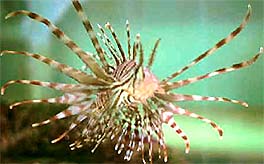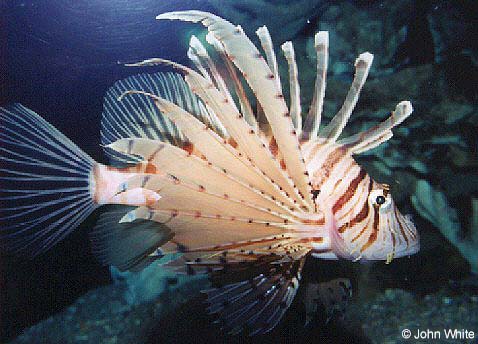Lion-fish, Turkey fish, Fire-fish
| Lion-fish, Turkey fish, Fire-fish Scorpaenidae The lion-fish belongs to the Scorpionfish family. Several smaller Indo-Pacific species of the genus Dendrochirus are also known as lion-fish, e.g. the HawaiianD. barberi and the reddish D. zebra found in the Orient. |
This brightly colored fish is usually found in coral reefs, especially in shallow waters of the Indo-Pacific region, hovering in caves or near crevices.Lion-fish have venomous fin spines that can produce painful puncture wounds. Fatalities, however, are rare. The fish have elongated dorsal fin spines and enlarged pectoral fins, and each species has a particular pattern of zebralike stripes.
A very famous
and highly venomous species is Pterois volitans. It reaches 30 cm
in length and is striped in red, brown, and white. It is often kept in
aquariums. |
|
A person punctured by one of the sharp spines will immediately feel strong pain. Rapid swelling of the affected body area develops which may make the movement of limbs very difficult. Lion-fish stings can cause nausea, breathing difficulties, paralysis, convulsions and collapse. Even death may occur in exceptional circumstances. Most people survive in spite of the great pain. The venom in the spines remains active for days, so even discarded spines should be treated with caution. It may take several months for a full recovery and if the sting is left untreated, gangrene may develop.
|
Medical treatment of stinging fish injuries
At first immerse the affected area (most often a hand or foot) into hot water. This is thought to improve the blood flow and disperse the venom. Local anaesthetic agents may provide deep relief in most cases and occasionally a nerve-block may be required. An X-ray of the wound should be performed to detect any presence of broken spines, so any possible infection can be prevented.


